Did you know multitasking actually reduces productivity? A study done by the American Psychological Association found that multitasking can reduce productivity up to 40%. When you batch tasks together it allows you to focus attention on one type of activity at a time, leading to more efficient work habits. And the increase in efficiency makes it even easier to create consistent content, which is essential for a successful blog. That is why the best way to stay on top of your blog is to batch content creation. We will go over a step-by-step guide on how to batch blog content to boost productivity and efficiency.
Do you want to watch this article? Here’s the video episode:
1. Brainstorm Ideas
Before diving into batching content, you need a pool of ideas. The best approach to generating ideas is by conducting keyword research. This not only provides ideas but also ensures that your content aligns with your target audience. If you’re unsure how to perform keyword research, check out our keyword research guide to get started.
2. Content Calendar
Once you have your content ideas, it’s time to create a plan. And there’s no better way to organize your content efforts than by creating a content calendar. A content calendar is essentially a schedule that dictates when each article will be published. It will be your roadmap for organizing your batch content creation process.
Feel free to plan your content calendar as far in advance as you like. I like to make a quarterly plan on my content calendar. However, while a quarter makes sense when coming up with content for the calendar, it may be too many articles to batch during content creation.
For the batch size, don’t get too carried away. Start in smaller chunks and gradually increase as you become accustomed to it. Begin by batching three to five articles. If you create weekly posts, start by batching one month of content. Then adjust as needed.
3. Write Articles
With your content ideas and calendar in place, it’s time to start creating your articles. It’s often most efficient to focus on one article at a time. Begin with the first article in your batch. Create an outline, write a rough draft of the content, and then edit it. Repeat this process for each article in your current batch.
4. Add Visuals
Once you’ve written your articles, it’s time to enhance them with visuals and relevant media. Go through each article individually and determine where images, graphics, or charts can improve the content.
5. Schedule Posts
Now it’s time to schedule your articles using your content management system (CMS). This will vary depending on your system. Below are the steps for scheduling content in WordPress:
- Go to Posts > Add New
- Input your article content
- On the right-hand side next to “Publish,” click “Immediately”
- Select the date and time for the post to go live in the menu that appears
- Once a future date is selected, the “Publish” button at the top will change to “Schedule”
- Click “Schedule” when you are finished
6. Repurpose Content
While the priority is creating blog content, you can also repurpose this content for various platforms, expanding its reach and impact. Consider the following options:
- Convert your article into a podcast episode: Reach audiences who prefer audio content and tap into podcast platforms to broaden your reach.
- Create a video summarizing its main points for YouTube: Engage visual learners and leverage the popularity of video content on YouTube to attract new viewers.
- Highlight content in an Instagram Reel or YouTube Short: Capitalize on short-form video trends to deliver quick, digestible content to your audience.
- Use the Instagram carousel feature to build a mini-course: Provide value-packed, educational content in a visually appealing format, ideal for Instagram users seeking in-depth knowledge.
By repurposing your blog content into these additional media types, you can significantly enhance its value and reach. Many people prefer consuming content in video or audio formats, making these repurposed versions highly valuable. After preparing the repurposed content, schedule it to go live either on the same day as your blog article or further into the future.
7. Post Publish Routine
After your article is live, there are additional steps to optimize visibility. We have a comprehensive post publish routine to follow that includes actions like optimizing internal linking, sharing with your followers, and embedding repurposed forms of media in the page such as a YouTube version of the article.
8. Utilize ClearPath Online
To streamline your blog content management, consider leveraging ClearPath Online. The ClearPath Online platform combines digital marketing coaching with an interactive digital marketing planner. It is designed to help boost your blog audience, while making it easier to stay on top of your content strategy.
In Summary
Many bloggers have found great success in batching content, including Amy Porterfield. She not only batches content, she now does what she refers to as “Mega Batching.”
I wanted to mega batch our podcast. That means we would batch the podcast ideas and then we would batch our outlines for our podcasts. We would then batch my podcast recordings and then we would batch the writing that goes into each podcast, the show notes, the emails, social media, and all that good stuff. We would batch that as well. This is not just batching but mega batching.
Amy Porterfield in episode 182 of the Online Marketing Made Easy Podcast
Batching blog content is the key to maintaining consistency and freeing up time for other projects. By batching your content, you can complete more in one sitting, allowing you to dedicate your remaining time to business growth. Conversely, creating new content every week can feel like treading water. Batching content is the strategy that empowers you to get ahead so it’s possible to focus on projects beyond content creation.
Do you want to listen to this article? Here’s the podcast episode:
